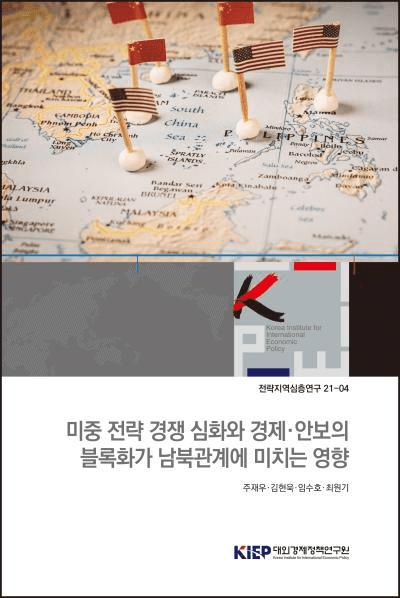Policy Analyses
Publications
Policy Analyses
To list

US-China Strategic Competition, Economic and Security Blocs: Impact on Inter-Korean Relations
North Korean economy, international politics
Author Jaewoo Choo, Hyun-Wook Kim, Sooho Lim, and Won-gi Choe Series 21-04 Language Korean Date 2021.12.30
The US’ strategy to contain China through the formation of allied blocs is materializing in multiple ways. America has one single goal. It intends to correct China’s international behavior. This stems from America’s intentions to correct what it perceives as fraudulent theft and exploitation of US information and technology on the part of China. In particular, the US is now engaged in efforts to subdivide and specify existing alliances according to its requirements.
There is widespread concern over the resurgence of a new Cold War stemming from America’s strategy to contain China. In the past, the Cold War signified an extended period of peace without world war, amid constant tension and confrontation between the two superpowers and heated competition in geopolitics over differing ideologies and strategic interests. This state of affairs made trade and exchange impossible between the two competing ideologies. Countries in one bloc could not establish diplomatic ties or engage in trade with countries in the other bloc.
During the Obama administration, the US military strategy was developed around the concept of AirSea Battle. To respond to China’s A2/AD strategy, the US focused on neutralizing China’s command and control system. However, the concept of AirSea Battle carried the risk of military conflict while aiming to deter China’s maritime expansion. After the Shale Revolution and the recovery of the US economy, the US military shifted to the Joint Concept for Access and Maneuver in Global Commons: JAM-GC.
During the Trump administration the US military began to transition toward the Joint Warfighting Concept, in which the role of ground forces was emphasized. The intention was to increase joint warfighting effectiveness in a contested environment. Due to COVID-19, this concept was finalized during the Biden administration. In response to China’s A2/AD in the East and South China Seas, the United States abrogated the 2019 Intermediate-Range Nuclear Forces Treaty (INF) and lifted its range restrictions of mid-to-long range missiles. Since then, the US has planned to deploy surface-launched ballistic missiles, missile defence systems, and electronic warfare forces in this region. In other words, with the deployment of these weapon systems, the US intends to be ready to counter Chinese surface-to-ship missiles like the DongFeng 21 and 29.
The Biden administration’s strategy of forming economic blocs is increasingly taking shape. First, in the field of trade and commerce, it continues the same retaliatory tariffs imposed by the Trump administration. This applies continued pressure on China to abide by the Phase One Agreement between the United States and China. At the same time, Biden continues to exert strong pressure on China to correct practices it regards as unfair and irrational, which are not related to the trade agreements but have a significant impact on trade between the US and China. The Biden administration is willing to accept the drawbacks from this “decoupling,” or weaker trade interdependence with China.
Second, the Biden administration is continuing and strengthening measures to exclude major Chinese telecommunications companies like Huawei from the US market under the pretext of security threats in the IT sector. These sanctions and measures were initiated by the former Trump administration, and are now being expanded against Chinese companies. The Biden administration is emphasizing that the IT sector is not only important in economic terms but also security terms within the strategic competition with China. To secure the upper hand, the US is likely to maintain the technology gap to pressure China and to maintain its technological dominance.
Third, the US is pursuing a strategy of establishing a new global supply chain that excludes China. The COVID-19 pandemic crisis revealed the vulnerability of the US manufacturing sector‘s supply chain. America is shifting from laissez-faire policies to active industrial policies that directly intervene in the market to rebuild the domestic manufacturing sector and foster its own companies.
In the US-China strategic competition landscape, the “objective needs” for inter-Korean cooperation are increasing, while the space for cooperation is gradually decreasing. The intense strategic competition of the US and China equates to growing influence by these superpowers on the political dynamics of the Korean Peninsula. As the US-China conflict escalates on the Korean Peninsula, the ROK-US alliance will be more important, having a distancing effect on the two Koreas. Accordingly, the autonomy of South Korea and North Korea in foreign relations, including Korean Peninsula issues, will decrease, and inter-Korean relations will be increasingly marginalized within the political dynamics surrounding the Korean Peninsula. As is well known, the most extreme form of such political dynamics on the Korean Peninsula was during the Cold War. The two Koreas belonged to different blocs centered on the US and Soviet Union, respectively, in effect reducing inter-Korean relations to military and ideological confrontations and conflicts. There is a high likelihood of this state of affairs appearing in future inter-Korean relations.
Sales Info
| Quantity/Size | 165 |
|---|---|
| Sale Price | 7 $ |
 공공저작물 자유이용허락 표시기준 (공공누리, KOGL) 제4유형
공공저작물 자유이용허락 표시기준 (공공누리, KOGL) 제4유형
대외경제정책연구원의 본 공공저작물은 "공공누리 제4유형 : 출처표시 + 상업적 금지 + 변경금지” 조건에 따라 이용할 수 있습니다. 저작권정책 참조
